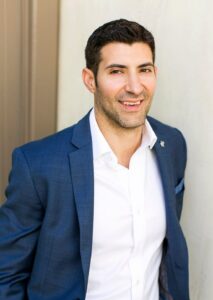Makers of The Metaverse: John Luxford of Flipside XR On The Future Of The VR, AR & Mixed Reality Industries
An Interview With Fotis Georgiadis
First, you need a ton of patience! Developing, optimizing, and the art process for VR, AR and MR can take a lot longer than even game development often does because of the constraints we’re faced with (higher frame rates on mobile-level devices, for example).
The Virtual Reality, Augmented Reality & Mixed Reality Industries are so exciting. What is coming around the corner? How will these improve our lives? What are the concerns we should keep an eye out for? Aside from entertainment, how can VR or AR help work or other parts of life? To address this, we had the pleasure of interviewing John Luxford.
John Luxford is an interdisciplinary artist whose passions include AR and VR, all things music, writing, and great coffee. As Co-Founder and CTO of Flipside XR, John leads the development of the VR app Flipside Studio to help storytellers, actors, and comedians create the future of immersive entertainment by turning any room into a stage. When he’s not lost in VR, you can hear him performing in one of several music projects including as a singer-songwriter, a one-man synthpop band, and as a quirky folk duo with his wife, Alyson.
Thank you so much for doing this with us! Before we dig in, our readers would like to get to know you a bit. Can you tell us a bit about your backstory and how you grew up?
I was born in Windsor, Ontario (right across the river from Detroit) and got into programming as a teenager in the 90’s, when the internet was just starting to become a global phenomenon. My high school had a great computer science class where we learned to make games on DOS.
I moved to Winnipeg, Manitoba in 1999 and found a job as a web developer. What I was really hired for was more like data entry but I managed to automate most of it within a few months so they kept me on as a developer.
That led to me running a web content management company for most of my 20’s, but I could feel myself losing interest in doing enterprise and university websites after a while. I wasn’t sure what I wanted to do next so I took a job making interactive experiences for adult education while I figured that out.
That led to working on the first VR project in Manitoba, a welding simulator, with two of my best friends. The three of us ended up quitting shortly after and starting a VR company called The Campfire Union. We created a bunch of experiments as well as things like a 360 video exhibit with the Canadian Museum for Human Rights and Lost Cities VR, which happened to be the first VR board game.
After working on these experiments, we came up with the idea for Flipside Studio — using VR to turn any room into a studio or stage. We’ve been working with performers to invent the future of immersive entertainment ever since.
Is there a particular book, film, or podcast that made a significant impact on you? Can you share a story or explain why it resonated with you so much?
In terms of VR and my career, The Diamond Age by Neal Stephenson. I tend to gravitate to reading classics because I inherited tons of old books from a family friend. But I also love all things science fiction.
A lot of people talk about Neal’s other book Snow Crash as their big VR influence, but he touches on some really interesting concepts in The Diamond Age that felt closer to the mark. There was a woman in the story who worked as a “ractor”, which meant acting in interactive experiences.
And now my team and I are building a virtual reality app that empowers actors to perform in real-time interactive shows.
Is there a particular story that inspired you to pursue a career in the X Reality industry? We’d love to hear it.
Our CEO Lesley Klassen was an absolute cheerleader for VR when the first Oculus Rift developer kits were released. You could say he helped us see past the low resolution, the really bad screen door effect and the lack of full 6 degrees-of-freedom motion tracking.
We had built a web app together before and things just felt like they were aligning for us to take the plunge and see what we could come up with. How often does an entirely new medium of computing come along? I got to experience the rise of early consoles like the Atari and NES, then the explosion of the internet, made my own CMS before WordPress even existed, and suddenly we’re watching the Oculus Rift kickstarter burst onto the scene. As creative people, this felt like the one for us.
Can you share the most interesting story that happened to you since you began this fascinating career?
It’s hard to narrow down one story in particular, but the journey of surviving for more than 8 years in the nascent XR industry has so many moments along the way. We had such humble beginnings. We started out in this tiny office with giant wrap-around cabinets for some reason and managed to cram upwards of 7 people in there at one point, sharing a larger office with friends from a handful of other interactive companies.
We made Lost Cities VR in that office, the first VR board game. We started by building a command line version and a test suite to ensure the core gameplay was working before plugging it into the VR interface. We met with the head of the Human Computing Interaction (HCI) lab at the local university and came up with a method of using Voronoi bubbles to make our menu easier to use without controllers because the original GearVR didn’t have them. That led to connecting with the Oculus Platform team and beta testing their SDK for them, which meant we were the first 3rd party title to launch using their multiplayer backend.
One time Rachael Hosein, our Chief Creative Officer, was in the Oculus keynote for a full minute while they introduced the Oculus Rift on stage. The photo was taken when we were first trying out the early Oculus Rift prototypes at GDC. There she was projected on the giant keynote stage with our company logo on her hoodie and everything.
And when we first started testing Flipside Studio with actors, we used to have to clear out a boardroom to set up one of the actors and another area on the other side of a big open office space for the other actor, with blankets hanging from the rafters for sound baffling. It’s that resourcefulness that I think I’m most proud of.
Can you share a story about the funniest mistake you made when you were first starting? Can you tell us what lesson you learned from that?
One of our first live theatre productions, for a show called Pixels, had so many issues the show almost didn’t happen. The first issue was the venue’s unreliable internet. With only a couple days until opening night, we ended up calling a local independent ISV to help. He had fiber installed in the building across the street so he solved it by climbing the roof and installing a dish on the roof that pointed at the back office of the venue, then putting another dish in the back office (which we had to beg for access to) so there was a line-of-sight connection that we could then route through a giant ethernet cable to reach the VR computers. Literally an internet superhero saved the show.
The venue also had no air conditioning, so with a room full of people the computers would start overheating. So we had to keep two doors open and place strategic fans for air flow, and handed out bottled water to all the guests.
Then at one point one of the headsets started blacking out during the show, so the actor had to slip it halfway off his head so he could see the projector screen as a reference for what he was doing. They were such pros that I’m not sure the audience even noticed.
But the show must go on, as they say, and in the end we sold out 9/10 shows and learned that glitches and technical issues can become opportunities for comedic effect. I’d say they actually made the show better!
None of us are able to achieve success without some help along the way. Is there a particular person who you are grateful towards who helped get you to where you are? Can you share a story about that?
There are so many people I could say but I think I’d go with Dave Smyth, my high school computer science teacher. He taught us to think on paper and in our heads and not be too reliant on the computer for problem solving. I’m pretty sure he hated having me as a student but his class and what he taught us definitely changed my life.
At the start of the school year he made the mistake of telling us that the last three months of class would be spent on one final assignment and to start thinking now about what we wanted to make. He gave us all the requirements up front, so I got to work right away. When we reached the start of the three months, I handed him a floppy disk with my already-completed assignment on it and said “see ya next year!” He was not happy with that life hack and changed the parameters the following year specifically to prevent me doing that again.
Are you working on any exciting new projects now? How do you think that will help people?
We have some exciting updates in the works with Flipside Studio, which includes a complete reimagining of our user interface around how people collaborate with each other in remote productions. I can’t say too much more about that at this time, but it’s going to save creators a lot of time and also open up new ways of working together creatively.
Ok super. Thank you for all that. Let’s now shift to the main focus of our interview. The VR, AR and MR industries seem so exciting right now. What are the 3 things in particular that most excite you about the industry? Can you explain or give an example?
Number one would be entertainers reaching wider audiences, and reaching them in new ways that aren’t just yet another video platform. Second for me is face and eye tracking, which bring a level of realism to social interactions in the metaverse that help avatars really come alive. I’m also really excited about the form factor of the hardware becoming slimmer with each new generation, which will help drive more mass adoption.
What are the 3 things that concern you about the VR, AR and MR industries? Can you explain? What can be done to address those concerns?
My biggest concerns about these metaverse industries are the harassment we’re starting to see, as well as the problems we’ve been experiencing in social media and video game culture being lifted into the metaverse. That worries me a lot and we don’t have great solutions for those things yet, but there are social models that can help alleviate some of them by bringing groups of friends together that already know each other instead of dumping semi-anonymous people together from anywhere. But it’s going to take careful and deliberate work on the part of metaverse creators and members alike to shape a healthy culture we all feel safe in, and I’m heartened to see conversations already happening around that.
I think the entertainment aspects of VR, AR and MR are apparent. Can you share with our readers how these industries can help us at work?
As we’ve seen throughout the pandemic, remote work is here to stay. Not for every job, but many people are clearly saying there’s no going back. Remote work using XR is still in its early stages and has a lot of room for improvement, but its potential is immense. There are just certain types of work that can’t be done well remotely with a keyboard and mouse, in a similar way to how certain things need to be seen and can’t just be imagined accurately out of the pages of a book, as amazing as our imagination is.
Over time, experiences and collaboration are going to blend more and more seamlessly into our world and we’re going to be able to do more and more things that seemed impossible even a few years ago. A case in point is the last immersive theatre production we put on took only ten minutes to set up, consisted of a couple VR headsets and a laptop, and when the director ended up having to quarantine right before the show, he was still able to seamlessly direct the show from home.
Are there other ways that VR, AR and MR can improve our lives? Can you explain?
I think a big one is putting yourself in other people’s shoes, experiencing something from their perspective, without having to visualize what that means. 360 video journalism, as well as experiences like Notes on Blindness or the Guardian’s 6×9 experience of solitary confinement, really display this potential well. It’s not necessarily easy for anyone to put themselves in someone else’s shoes and empathize naturally, and there are a ton of assumptions in that process too including what’s outside of the frame when a photojournalist takes a shot that having a stronger visual and auditory link I think can really connect and create that empathetic experience.
What are the “myths” that you would like to dispel about working in your industry? Can you explain what you mean?
The number one myth that I would like to dispel is that the audience isn’t large enough to make VR valuable yet. Headset adoption is growing significantly, and VR impacts audiences both through the at-home user who is lucky enough to have a headset already and through location-based experiences. On top of this, VR tools like Flipside Studio make production of content for both immersive and non-immersive screens a lot more accessible. Content created in VR can also be seen by audiences on all screens and platforms, from social media to broadcast to live theatre.
What are your “5 Things You Need To Create A Highly Successful Career In The VR, AR or MR Industries?” (Please share a story or example for each.)
First, you need a ton of patience! Developing, optimizing, and the art process for VR, AR and MR can take a lot longer than even game development often does because of the constraints we’re faced with (higher frame rates on mobile-level devices, for example).
Solid programming skills and an understanding of game engines (mainly Unity and Unreal) are important. 3D artists who can make low polygon, mobile-friendly art look amazing will be in high demand.
Business skills, like any other industry, are always needed. And I think there’s a big place for performers and storytellers of all kinds as we’re still early in the process of discovering what works and what doesn’t content-wise, so those skills will continue to be in demand as well.
You are a person of great influence. If you could inspire a movement that would bring the most amount of good to the most amount of people, what would that be? You never know what your idea can trigger. 🙂
We are creating tools at Flipside XR to democratize immersive storytelling. There are important and engaging stories to be told through VR, AR and MR and a lot of barriers to getting them to audiences. The movement I want to build is to help storytellers have an impact on the future of immersive content creation with access to production tools that can transform any room into a stage.
We are very blessed that very prominent leaders read this column. Is there a person in the world, or in the US with whom you would like to have a private breakfast or lunch, and why? He or she might just see this if we tag them 🙂
Neil Stephenson. Not only because of the impact that I mentioned he had on what I’m now working on, but because science fiction storytellers have a way of reflecting on humanity and the universe to present what could be possible, possible versions of ourselves. While the “metaverse” is still just in its infancy for many of us, I know he’s been thinking about what that means for society since before he coined the term.
As a society, we’ve only really understood the impacts of many technologies after their effects have become apparent at scale, after the chance to reflect and really be intentional about them has passed. We’re now facing a brand new frontier of immersion that is going to change our relationship with technology all over again. Some amazing things are becoming possible and real connections are being made because of them, and some not so good things too. We need more critical thinkers and discourse to shape the way forward and ensure, to the best of our ability, that we do so with intentionality and purpose.
Thank you so much for these excellent stories and insights. We wish you continued success on your great work!
Makers of The Metaverse: John Luxford of Flipside XR On The Future Of The VR, AR & Mixed Reality… was originally published in Authority Magazine on Medium, where people are continuing the conversation by highlighting and responding to this story.



